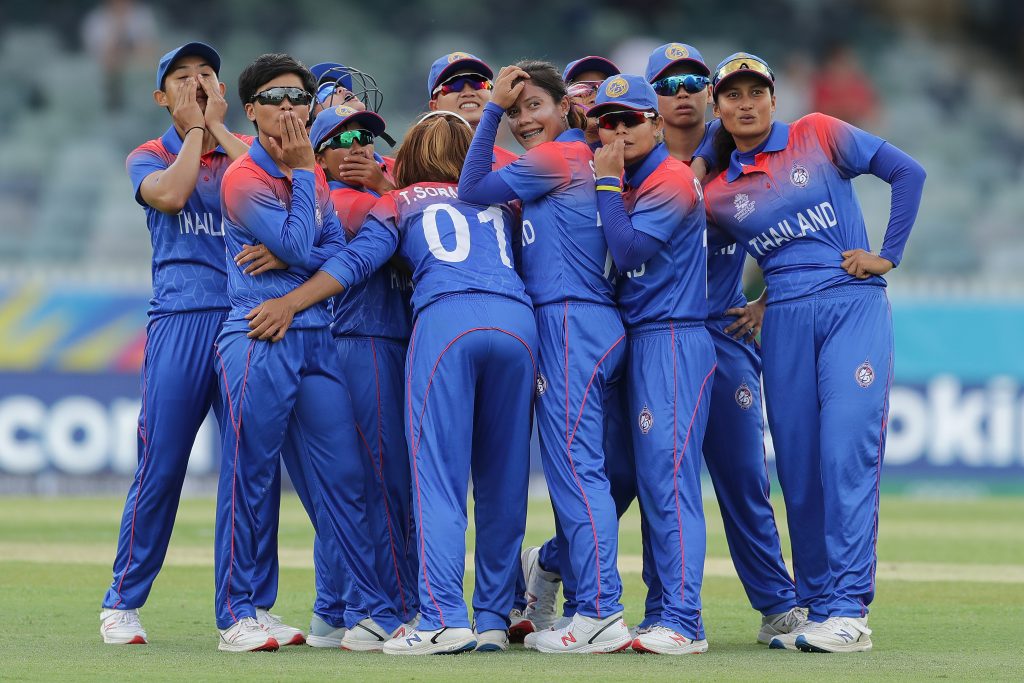If you watched Beyond the Boundary, a new Netflix documentary about the highest profile International Cricket Council (ICC) Women’s World T20 World Cup to date, you might recall a few things about Thailand.
You may remember Sornnarin Tippoch’s unadulterated excitement at captaining her country on the biggest stage, matched only by her desire to show the world that Thailand could compete.
You may have been pleasantly surprised at Thailand’s ability to compete, albeit in flashes: Suleeporn Laomi’s run out of West Indian star Deandra Dottin; Nannapat Khoncharoenkrai’s expert stumping of England opener Amy Jones; and Nattakan Chantham’s piercing cover drives against Pakistan.
You might have heard world famous commentators fall one-by-one to Thailand’s skill, charm, and unique brand of cricket, from Lisa Sthalekar’s “I love Thailand” refrain, to Ian Bishop waxing lyrical about his “new favourite player [Chantham].”
Thailand made an impression at the World Cup, and Beyond the Boundary ensures that they will not be forgotten. They may yet qualify for the next World Cup, and the one after.
However, there is a more immediate, pressing question: What next?
History’s answer to this question is that there are no givens.
In the men’s game, Ireland’s steady rise is the antithesis to Kenya’s sharp decline from the heights of a World Cup semi-final. Oman’s emergence is paralleled by Bermuda’s fall from grace. Even countries with Test status – Zimbabwe being a prime example – are far from immune to the vicissitudes of global cricket.
In the women’s game, there are hardly any precedents for breaking the World Cup glass ceiling and then staying in that ether. In some ways, the latter challenge – the ability to stay at those dizzying heights – constitutes a new glass ceiling. Denmark, Netherlands, and Ireland all played World Cups in the nineties, the latter also making appearances in previous T20 World Cups. Today Denmark does not even participate in the European regional qualifiers.
The aftermath of a World Cup is unchartered and ostensibly dangerous territory for Thailand, a country without a discernible cricketing culture, an elite-level women’s domestic competition, a major sponsor, or a fan base.
Unlike Afghanistan who rode to Full Member status on the back of a dominant men’s team (and no women’s team), it is unlikely that Thailand will be able to do the same on the coat tails of their women, all else equal. No team has acquired Full Member status because of the success of its women’s team. Rightly or wrongly, Full Members like Bangladesh still have to qualify for World Cups. Parity between the men and women’s game only goes so far.
Let us get COVID-19 out of the way. Yes, the pandemic disrupted the team’s immediate post-World Cup plans. Upon their return from Australia, team members went into a strictly enforced national lock down. This has now been eased, and the players are back in training.
Yes, COVID-19 also means that Thailand has no international competition to look forward to in the near future. The Women’s Quadrangular 50-Over series in April 2020 between Ireland, Netherlands, Zimbabwe and Thailand was cancelled, and the ICC Women’s Cricket World Cup Qualifier, initially scheduled for July 2020 in Sri Lanka, has now been postponed a year.
However, COVID-19 should not mask fundamental questions about how Associate teams like Thailand ensure continuity of success after the pinnacle of a World Cup appearance.
Thailand needs regular T20 and 50-Over competition against better opposition. Pakistan, Bangladesh, Sri Lanka, and the West Indies are obvious options. However, these countries have no financial or cricketing incentive to play Thailand. If whispers, that direct entry into the next ICC Women’s T20 World Cup will be based on rankings, are true, then teams ranked above Thailand will not want to cede games and ranking points to Thailand.
Moreover, there is nothing in ICC’s governance or competition framework that compels Full Members to play lower ranked challengers. In 50-Over cricket, Thailand does not participate in the ICC Women’s Championship, limited to the top eight ranked countries. Indeed, Thailand does not even possess ODI status.
In effect, Thailand is locked out of guaranteed game time against higher ranked teams, unless the Cricket Association of Thailand itself can negotiate individual series with other boards.
One clear pathway forward could be to introduce a second tier of regular league competition for women’s teams ranked 7 – 16, with promotion and relegation to and from a top tier league. As Daniel Beswick has convincingly argued in the context of the men’s 50-Over game, these leagues not only provide regular opportunities for emerging teams, they create stakes, context, and intrigue, in an increasingly staid calendar filled with bilaterals and trilaterals.
Of course, solutions such as these abound, but as with everything in cricket, their realisation depends on ICC’s richest and most influential members.

Franchise leagues also have a role to play in the future, as they continue to grow in size and financial clout in coming years. Today opportunities in the Women’s Big Bash League (WBBL), the Women’s Indian Premier League (IPL), and the Kia Super League are understandably rare and the handful of overseas slots are given to the world’s best. But a number of Thai players are already clearly capable of holding their own. It only takes one player of the ilk of Suleeporn Laomi to shine, for other owners and coaches to think more broadly about their options.
In the interim, initiatives such as the WBBL Associate Rookie program must continue, and include provision for players to debut in the league itself.
Until some of these structural problems are fixed, Thailand will once again confront the obscurity, and financial fragility of playing in the Associate world. The players will continue dealing with the challenge of a semi-professional lifestyle: of balancing university or work with training and of travelling back to their provinces to help their families.
The taste of cricket at the highest level will no doubt keep them motivated enough regardless. Emerging Cricket Ambassador Natthakan Chantham shares the same sentiment.
“Being able to compete with world class teams put things into perspective – it showed us how much hard we have to work both mentally and technically … I have personally promised myself to improve my game and be ready when the next occasion comes around.”
Until that occasion does come around, the players will have to re-acclimatise to rough outfields, poorer wickets, lower standards, and the almost complete absence of attention. They will have to start again, sort of.
The Cricket Association of Thailand (CAT) will also have to do its bit and more. It has to ensure that its seasoned core do not leave the sport for lack of opportunity. It will have to look towards its own – governments, coaches, grounds people, and volunteers – to prepare for the future: to invest in the next generation, to build a domestic competition, to find quality opposition, to expose its best players to overseas leagues, and to qualify for another World Cup.
Some of these foundations were already in place before COVID-19 struck, but they must continue. One potential long-term positive is that cricket will be part of the 2022 Asian Games. Should Thailand send a women’s cricket team – and there is no reason why it will not – the Sports Authority of Thailand will provide professional contracts to players and staff in the year leading up to the Games.
Until then, fans of the Thailand women’s team will hold on to what they saw and heard in Beyond the Boundary: in particular, a tearful Naruemol Chaiwai telling the world “I want to be in the next World Cup” or Natthakan Chantham’s promise of “after the tournament, we will keep working hard. You will see us again, kaa … I will be back again in two years, yes, for sure.”
You’re reading Emerging Cricket — brought to you by a passionate group of volunteers with a vision for cricket to be a truly global sport, and a mission to inspire passion to grow the game.
Be sure to check out our homepage for all the latest news, please subscribe for regular updates, and follow EC on Twitter, Facebook, LinkedIn and YouTube.
Don’t know where to start? Check out our features list, country profiles, and subscribe to our podcast.
Support us from US$2 a month — and get exclusive benefits, by becoming an EC Patron.







